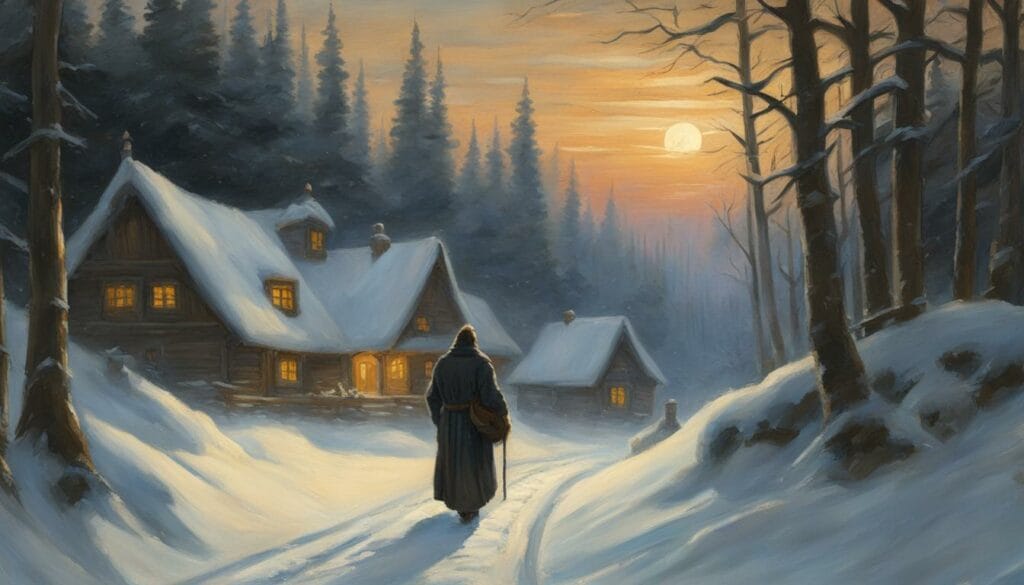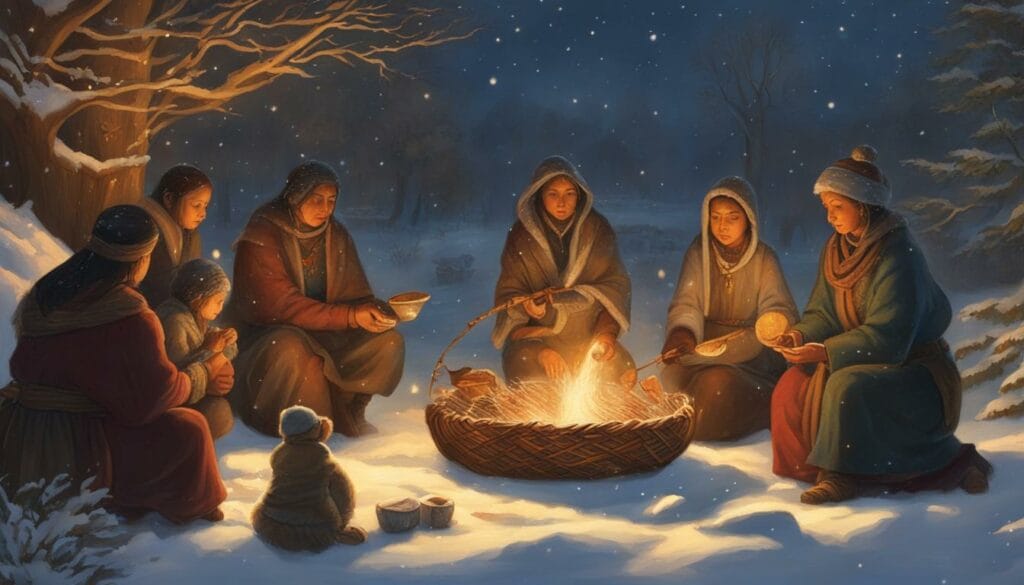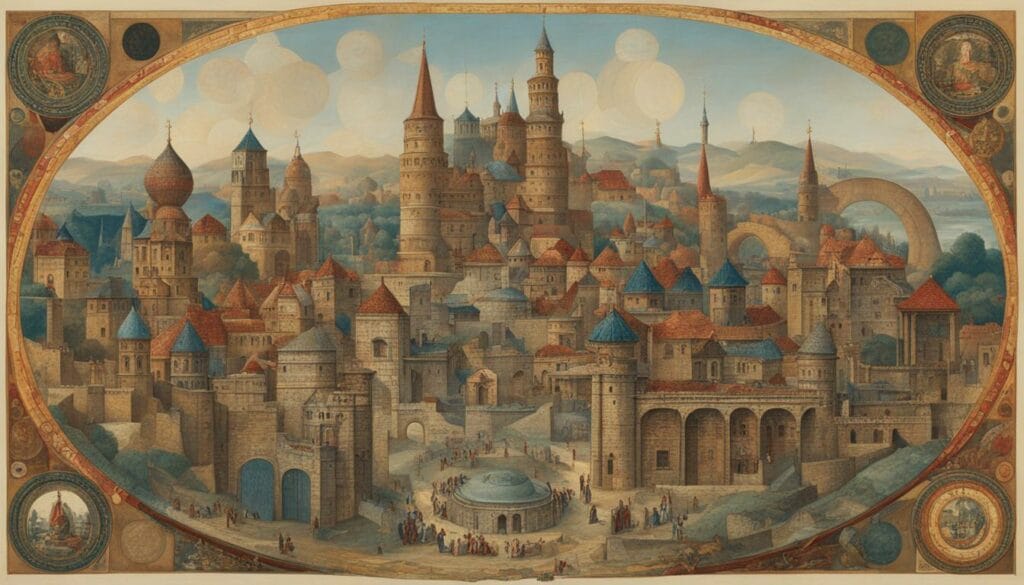Kris Kringle Origin: The Man, The Myth, The Magic
During the Christmas season, Kris Kringle, also known as Santa Claus, brings joy and excitement to children all over the world. But where did this beloved character come from, and what is the magical story behind him?

Key Takeaways:
- Kris Kringle is based on the Christian bishop Saint Nicholas, known for his generosity towards children.
- The popularized image of Kris Kringle began with the publication of “A Visit from St. Nicholas” in the 19th century.
- The image of Kris Kringle has evolved over time, but the magic of this beloved character remains constant.
The Origin of Kris Kringle
The origin of “Kris Kringle” is a bit convoluted due to the blending of various Christmas traditions and figures over time. The name “Kris Kringle” is actually a mispronunciation of “Christkind” or “Christkindl,” which is German for “Christ Child.” The Christkind is a traditional Christmas gift-bringer in parts of Germany, Austria, and other European countries. According to this tradition, the Christkind, an angelic figure often depicted with blond hair and wings, brings presents to children on Christmas Eve.
The figure of St. Nicholas, a 4th-century Christian bishop known for his generosity and for being the patron saint of children, is indeed one of the primary inspirations for the modern-day Santa Claus. St. Nicholas had a reputation for secret gift-giving, such as putting coins in the shoes of those who left them out for him, and thus became the model for Santa Claus, whose name comes from the Dutch “Sinterklaas,” a shortened form of Sint Nikolaas (Saint Nicholas).
The confusion between Kris Kringle and St. Nicholas likely stems from the merging of traditions brought by immigrants to the United States. In America, these various gift-bringing figures, including St. Nicholas, the Christkind, and others, eventually became part of the melting pot of Christmas lore, leading to the creation of the American version of Santa Claus.
Over time, in American culture, “Kris Kringle” became another name for Santa Claus, further blending the identities of the Christkind and St. Nicholas. Despite the different origins and traditions behind each name, Kris Kringle and Santa Claus are now often used interchangeably in the United States to refer to the jolly man in the red suit who delivers gifts to children on Christmas Eve.
The Origins of Christmas Gift-Giving
Christmas gift-giving has become a beloved tradition around the world, but have you ever wondered where this custom originated? The history of gift-giving during the Christmas season can be traced back centuries ago, to ancient Roman and pagan celebrations.
During the Roman festival of Saturnalia, which occurred in December, people exchanged gifts to honor the god Saturn. Similarly, in Scandinavia, the pagan festival of Yule featured gift-giving to celebrate the winter solstice.
But as Christianity spread throughout Europe, the tradition of gift-giving during the Christmas season began to evolve. In the 4th century, the Christian church designated December 25 as the official celebration of the birth of Jesus Christ. Gift-giving became a way to commemorate the gifts of the Magi to the baby Jesus.
In many European countries, gift-giving occurred on St. Nicholas Day, which is celebrated on December 6. The legend of St. Nicholas, a bishop from the 4th century, involves him giving gifts to children. This tradition eventually evolved into the modern-day Santa Claus character.
Overall, the origins of Christmas gift-giving are a blend of ancient customs and religious traditions, that to this day continue to bring joy and happiness to people all over the world.

The Legend of Saint Nicholas
Embark on a journey back in time to explore the origins of the beloved Kris Kringle. The modern-day Kris Kringle and Santa Claus find their inspiration in the legendary figure of Saint Nicholas, a fourth-century bishop from Myra, a small town in modern-day Turkey.
According to historical accounts and folklore, Saint Nicholas was known for his exceptional kindness, generosity, and compassion towards the less fortunate. He was admired as the protector of children and sailors, and revered as the patron saint of merchants, thieves, and pawnbrokers.
As the story goes, Saint Nicholas became famous for his charitable deeds when he helped a poor man and his three daughters. Unable to afford dowries, the daughters faced the prospect of being sold into slavery. Saint Nicholas anonymously provided the family with gifts of gold, tossed through their window at night, to ensure the daughters had the dowry they needed to marry. The act of Saint Nicholas’ kindness has inspired the gift-giving tradition of Christmas to this day.

“Generosity is giving more than you can, and pride is taking less than you need.” – Saint Nicholas
The lore surrounding Saint Nicholas gradually spread throughout Europe over time, thanks to the efforts of Christian missionaries. It wasn’t until the 16th century in Germany that Saint Nicholas evolved to become Kris Kringle, a character who embodied the spirit of Christmas and gift-giving. The name “Kringle” is derived from the German word “Christkindl,” which translates to “Christ child.”
As Christianity spread throughout the world, Kris Kringle’s image evolved, becoming the modern-day Santa Claus. Some aspects of Saint Nicholas’ character merged with the Germanic god Odin, and other folkloric traditions, to create the lovable, rotund man in a red suit that we know today.
The legend of Saint Nicholas remains a significant part of Christmas folklore and tradition, inspiring acts of kindness and generosity towards all. While the character may have evolved throughout the centuries, the essence of Kris Kringle’s spirit remains constant, embodying the magic of the holiday season.
The Evolution of Kris Kringle
Over time, the character of Kris Kringle became more commercialized and secularized. In the early 19th century, the figure of Kris Kringle began to appear in American literature, most famously in the poem “A Visit from St. Nicholas” by Clement Clarke Moore. This poem helped to cement the image of Kris Kringle as a jolly, rotund man with a white beard and a red suit, riding in a sleigh pulled by reindeer.
As the image of Kris Kringle became more popular, it began to merge with that of Santa Claus, another figure associated with gift-giving during the Christmas season. Today, the characters of Kris Kringle and Santa Claus are often used interchangeably, with both characters representing the spirit of generosity and goodwill.

Despite the changes that the character of Kris Kringle has undergone over time, the underlying message remains the same. As the embodiment of the spirit of giving and kindness, Kris Kringle teaches us the importance of spreading joy and happiness during the holiday season.
The Evolution of Santa Claus
While Kris Kringle’s story has remained relatively consistent over time, Santa Claus has undergone significant changes in his appearance and mythology. The modern-day image of Santa Claus as a rotund, white-bearded figure in a red and white suit was largely popularized in the United States during the 20th century.
However, this version of Santa Claus is just the latest in a long line of interpretations. Throughout history, Santa Claus has been depicted in a variety of ways, ranging from a tall, thin man to a small, mischievous creature.
Despite these variations, the core of Santa Claus’ mythology has remained the same: a generous, giving figure who brings joy and delight to children during the Christmas season.
| Kris Kringle | Santa Claus |
|---|---|
| Originated in German folklore in the 16th century | First appeared in a poem in the United States in the 1820s |
| Also known as Christkind or Christkindl | Derived from Saint Nicholas, a legendary figure in Christianity |
| Often depicted as an angelic figure with a white robe and wings | Evolved into a rotund, jolly man in a red and white suit |
| Associated with gift-giving and the Christmas season | Associated with gift-giving and the Christmas season |
Regardless of their differences, Kris Kringle and Santa Claus remain beloved figures in Christmas folklore, embodying the spirit of giving and joy that defines the holiday season.
The Magic of Kris Kringle
Kris Kringle is often depicted as a bearded man dressed in red, carrying a sack full of toys for children. This image has become synonymous with the Christmas season, a reminder of the joy and wonder that comes with the holiday.
“He had a broad face and a little round belly, that shook, when he laughed, like a bowlful of jelly!”
Perhaps one of the most iconic aspects of Kris Kringle is his infectious laugh. It is said that his laughter can be heard all around the world, spreading joy and happiness wherever it goes.
Whether you believe in the magic of Kris Kringle or not, there is no denying the joy and excitement that he brings to the holiday season. As you celebrate this special time with your loved ones, take a moment to embrace the spirit of Kris Kringle and all that he represents.
Gift-Giving in the Spirit of Kris Kringle
Kris Kringle embodies the spirit of generosity and kindness, so when choosing gifts for your loved ones, keep this in mind. Consider giving gifts that promote love and connection, such as a family board game or a personalized photo album.
You can also give gifts that support local artisans or charities, as Kris Kringle encourages us to spread joy and goodwill to our communities.
By embracing the spirit of Kris Kringle and Santa Claus, you can create a holiday season that is full of magic, joy, and generosity.
FAQ
What is the origin of Kris Kringle?
Kris Kringle, also known as Santa Claus, has origins that can be traced back to various sources. The character of Kris Kringle is based on Saint Nicholas, a Christian saint known for his generosity and gift-giving. The modern-day image of Santa Claus was popularized in the United States in the 19th century, drawing inspiration from various cultural traditions and folklore.
How does Kris Kringle relate to the tradition of Christmas gift-giving?
The tradition of gift-giving during Christmas is believed to have its roots in ancient customs and celebrations. Kris Kringle, as a symbol of generosity and joy, has become closely associated with this tradition. Many cultures around the world embrace the spirit of Kris Kringle by exchanging gifts during the holiday season as a way to spread happiness and love.
Who is Saint Nicholas and how is he connected to Kris Kringle?
Saint Nicholas was a Christian saint who lived during the 4th century in the region that is now modern-day Turkey. He was known for his acts of charity and kindness, particularly towards children. Over time, the legendary stories and folklore surrounding Saint Nicholas became intertwined with the character of Kris Kringle, forming the basis for the modern-day Santa Claus figure.
How has the image of Kris Kringle evolved throughout history?
The image of Kris Kringle has evolved over time, influenced by different cultures and traditions. From ancient pagan celebrations to Christian folklore, various elements and characteristics have shaped the portrayal of Kris Kringle. In the modern era, the image of Santa Claus as a jolly, white-bearded man in a red suit was popularized through literature, art, and advertising.
What is the connection between Kris Kringle and Santa Claus?
Kris Kringle and Santa Claus are often used interchangeably to refer to the same figure. Kris Kringle is an older name derived from German and Dutch folklore, while Santa Claus is the modern-day English name for the character. Both names represent the beloved figure associated with Christmas, known for bringing gifts to children and spreading holiday cheer.
What is the magic of Kris Kringle?
The magic of Kris Kringle lies in the joy and wonder he brings during the holiday season. He embodies the spirit of giving, kindness, and goodwill. The stories and traditions associated with Kris Kringle evoke a sense of enchantment and create cherished memories for children and adults alike.
How can I embrace the spirit of Kris Kringle in my own life?
Embracing the spirit of Kris Kringle can be done through various Christmas traditions and acts of kindness. You can participate in gift-giving, spread joy and cheer to others, and engage in activities that create lasting memories with your loved ones. Embodying the generosity and warmth that Kris Kringle represents is a wonderful way to celebrate the magic of Christmas.




